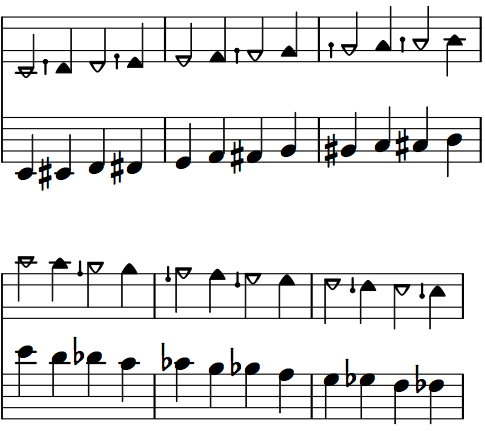TwinNote has its own alternative accidental signs that it uses to indicate:
- That a note is an accidental (i.e. not in the current key).[1]
- The note’s name, whether it is a sharp, flat, double sharp, double flat, etc.
They do not indicate to the musician that they should play the following note higher or lower like traditional accidental signs do. They simply clarify the names of accidental notes but do not affect their pitch.[2] It is possible for a musician to ignore the accidental signs and still play the correct notes in TwinNote.
In other words, while conventional accidental signs convey essential instructions (“sharpen/flatten the following note”), TwinNote’s accidental signs convey supplementary information (effectively, “the following note has (already) been sharpened/flattened”).
Since TwinNote’s alternative accidental signs carry a different meaning than traditional sharp and flat signs, new symbols are used — simple “matchstick” symbols pointing up for sharp or down for flat. These symbols are more visually subtle and take up less horizontal space than traditional accidental symbols.
Above is an illustration of two pairs of enharmonically equivalent notes — notes like the black keys on a piano that have different names but have the same pitch (in 12-tone equal temperament[2]). In TwinNote it is much clearer that they have the same pitch. The alternative accidental signs simply indicate their different names but do not affect their pitch. Differentiating between enharmonic equivalents using TwinNote’s accidental signs and Key Signatures makes it possible to use the standard Names of Notes and Intervals.
TwinNote’s accidental signs remain in effect until the end of the measure in which they appear, just like traditional accidental signs. In TwinNote fewer accidental signs are needed as compared with traditional notation since twelve different notes have their own representation on the staff instead of just seven. Cancellation accidentals (that override a previous accidental in the same measure) would be much rarer in TwinNote. The following measure containing alternating D natural and D sharp notes illustrates this point.
Traditional natural signs can be used to indicate natural notes that are outside of the current key, just as in traditional notation. For example, a B natural note in the key of B flat.[3] Double sharps and double flats are indicated by simply doubling the alternative sharp and flat symbols:
Here is an illustration of an ascending and descending chromatic scale in TwinNote and traditional music notation. All of these illustrations were created using LilyPond.

Next: Names of Notes and Intervals
- This is helpful information for musicians to have in any case. For one thing, it reassures them that they are playing the correct note, even if it sounds out of place. Return
- This assumes the standard tuning system of 12-tone equal temperament. Of course, in other tuning systems the pitch of “enharmonically equivalent” notes may differ slightly. In that case TwinNote’s accidental signs and key signatures indicate these subtle shifts in pitch/intonation, as well as the different names of the notes. See the Enharmonic Equivalents tutorial on the Music Notation Project’s site. Return
- This use of traditional natural signs is still a provisional “work-in-progress”. The other option would be to use the same “matchstick” symbols for natural notes. For example, you could indicate that a note was raised from a Bb (in the key signature) to a B (as an accidental outside the key) by using an upwards-pointing matchstick accidental sign rather than a traditional natural sign. Return